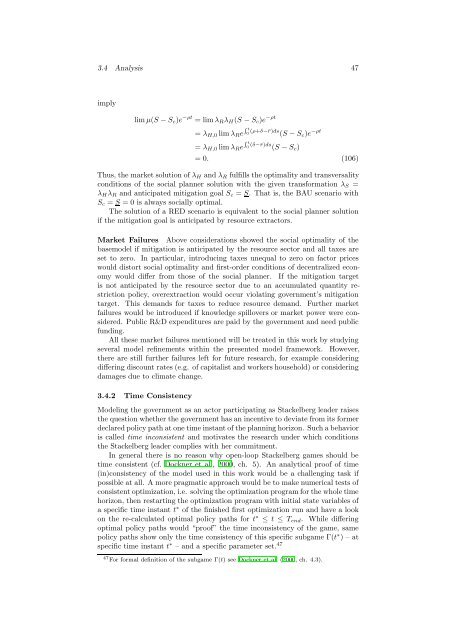Modeling Climate Policy Instruments in a Stackelberg Game with ...
Modeling Climate Policy Instruments in a Stackelberg Game with ...
Modeling Climate Policy Instruments in a Stackelberg Game with ...
You also want an ePaper? Increase the reach of your titles
YUMPU automatically turns print PDFs into web optimized ePapers that Google loves.
3.4 Analysis 47<br />
imply<br />
lim µ(S − S c )e −ρt = limλ R λ H (S − S c )e −ρt<br />
= λ H,0 lim λ R e R t<br />
0 (ρ+δ−¯r)ds (S − S c )e −ρt<br />
= λ H,0 lim λ R e R t<br />
0 (δ−¯r)ds (S − S c )<br />
= 0. (106)<br />
Thus, the market solution of λ H and λ R fulfills the optimality and transversality<br />
conditions of the social planner solution <strong>with</strong> the given transformation λ S =<br />
λ H λ R and anticipated mitigation goal S c = S. That is, the BAU scenario <strong>with</strong><br />
S c = S = 0 is always socially optimal.<br />
The solution of a RED scenario is equivalent to the social planner solution<br />
if the mitigation goal is anticipated by resource extractors.<br />
Market Failures Above considerations showed the social optimality of the<br />
basemodel if mitigation is anticipated by the resource sector and all taxes are<br />
set to zero. In particular, <strong>in</strong>troduc<strong>in</strong>g taxes unequal to zero on factor prices<br />
would distort social optimality and first-order conditions of decentralized economy<br />
would differ from those of the social planner. If the mitigation target<br />
is not anticipated by the resource sector due to an accumulated quantity restriction<br />
policy, overextraction would occur violat<strong>in</strong>g government’s mitigation<br />
target. This demands for taxes to reduce resource demand. Further market<br />
failures would be <strong>in</strong>troduced if knowledge spillovers or market power were considered.<br />
Public R&D expenditures are paid by the government and need public<br />
fund<strong>in</strong>g.<br />
All these market failures mentioned will be treated <strong>in</strong> this work by study<strong>in</strong>g<br />
several model ref<strong>in</strong>ements <strong>with</strong><strong>in</strong> the presented model framework. However,<br />
there are still further failures left for future research, for example consider<strong>in</strong>g<br />
differ<strong>in</strong>g discount rates (e.g. of capitalist and workers household) or consider<strong>in</strong>g<br />
damages due to climate change.<br />
3.4.2 Time Consistency<br />
<strong>Model<strong>in</strong>g</strong> the government as an actor participat<strong>in</strong>g as <strong>Stackelberg</strong> leader raises<br />
the question whether the government has an <strong>in</strong>centive to deviate from its former<br />
declared policy path at one time <strong>in</strong>stant of the plann<strong>in</strong>g horizon. Such a behavior<br />
is called time <strong>in</strong>consistent and motivates the research under which conditions<br />
the <strong>Stackelberg</strong> leader complies <strong>with</strong> her commitment.<br />
In general there is no reason why open-loop <strong>Stackelberg</strong> games should be<br />
time consistent (cf. Dockner et al., 2000, ch. 5). An analytical proof of time<br />
(<strong>in</strong>)consistency of the model used <strong>in</strong> this work would be a challeng<strong>in</strong>g task if<br />
possible at all. A more pragmatic approach would be to make numerical tests of<br />
consistent optimization, i.e. solv<strong>in</strong>g the optimization program for the whole time<br />
horizon, then restart<strong>in</strong>g the optimization program <strong>with</strong> <strong>in</strong>itial state variables of<br />
a specific time <strong>in</strong>stant t ∗ of the f<strong>in</strong>ished first optimization run and have a look<br />
on the re-calculated optimal policy paths for t ∗ ≤ t ≤ T end . While differ<strong>in</strong>g<br />
optimal policy paths would “proof” the time <strong>in</strong>consistency of the game, same<br />
policy paths show only the time consistency of this specific subgame Γ(t ∗ ) – at<br />
specific time <strong>in</strong>stant t ∗ – and a specific parameter set. 47<br />
47 For formal def<strong>in</strong>ition of the subgame Γ(t) see Dockner et al. (2000, ch. 4.3).
















